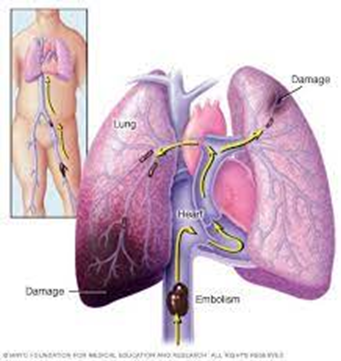A nurse is caring for a client admitted with pneumonia caused by Streptococcus pneumoniae. Which of the following types of pneumonia is Streptococcus pneumoniae?
Typical pneumonia
Chemical pneumonitis
Atypical pneumonia
Aspiration pneumonia
The Correct Answer is A
Choice A Reason:
Typical pneumonia is correct. Streptococcus pneumoniae is a common bacterial pathogen that causes typical pneumonia, also known as community-acquired pneumonia (CAP). Typical pneumonia is characterized by an acute onset of symptoms such as fever, productive cough with purulent sputum, chest pain, and difficulty breathing. Streptococcus pneumoniae is one of the most common causes of typical pneumonia, especially in community settings.
Choice B Reason:
Chemical pneumonitis is incorrect. chemical pneumonitis, refers to inflammation of the lung tissue caused by inhalation or aspiration of toxic chemicals, gases, or gastric contents. It is not caused by Streptococcus pneumoniae.
Choice C Reason:
Atypical pneumonia is incorrect. Atypical pneumonia, refers to pneumonia caused by atypical pathogens such as Mycoplasma pneumoniae, Chlamydophila pneumoniae, and Legionella pneumophila. Atypical pneumonia typically presents with milder symptoms compared to typical pneumonia and may not respond to traditional antibiotics used for typical bacterial pneumonia.
Choice D Reason:
Aspiration pneumonia. Aspiration pneumonia, occurs when foreign material, such as food, saliva, or gastric contents, is aspirated into the lungs, leading to inflammation and infection. While Streptococcus pneumoniae can cause pneumonia in the context of aspiration, it is more commonly associated with typical pneumonia acquired through inhalation of respiratory droplets containing the bacteria.
Nursing Test Bank
Naxlex Comprehensive Predictor Exams
Related Questions
Correct Answer is D
Explanation
Correct answer: D
Choice A Reason:
Decreased pulmonary vascular resistance is incorrect. Inflammatory mediators released in response to a pulmonary embolism can lead to vasoconstriction and increased pulmonary vascular resistance. This is part of the body's response to redirect blood flow away from the affected area of the lung and maintain adequate perfusion to other areas.
Choice B Reason:
Hypercapnia is incorrect. Hypercapnia refers to elevated levels of carbon dioxide (CO2) in the blood.Hypocapnia usually is present with embolism; hypercapnia, on the other hand, is rare.
Choice C Reason:
Hypoventilation is incorrect. Hypoventilation occurs when there is inadequate ventilation of the lungs relative to metabolic demands. In the context of a pulmonary embolism, hypoventilation can occur due to factors such as pain, respiratory muscle fatigue, or impaired gas exchange, all of which can be influenced by the release of inflammatory mediators.
Choice D Reason:
Respiratory alkalosis is correct.In response to the blockage and the resulting inflammation, the body often increases the respiratory rate as a compensatory mechanism to maintain adequate oxygen levels and remove carbon dioxide.Due to the increased breathing rate, there is excessive exhalation of carbon dioxide, leading to a decrease in the partial pressure of CO2 in the blood. This results in an increase in blood pH, causing respiratory alkalosis.

Correct Answer is ["A","B","C","D","E","F"]
Explanation
Choice A Reason:
Refraining from climbing ladders is appropriate. Climbing ladders involves a risk of falling, which can be particularly hazardous for individuals with epilepsy. Seizures can occur unexpectedly and may cause loss of muscle control or consciousness, increasing the risk of falls from heights such as ladders. Falling from a ladder during a seizure can result in serious injuries, including head trauma, fractures, or other injuries from impact. Advising the client to refrain from climbing ladders helps mitigate the risk of falls and associated injuries during a seizure episode, promoting their safety and well-being.
Choice B Reason:
Do not go swimming without a partner is inappropriate. Swimming alone can be dangerous for individuals with epilepsy as they may be at risk of drowning if they experience a seizure while in the water. Having a swimming partner can provide assistance and ensure safety in case of a seizure.
Choice C Reason:
Refraining from driving unless seizure-free for 3 months is appropriate. Driving restrictions are often recommended for individuals with epilepsy to minimize the risk of accidents caused by seizures. Many jurisdictions require individuals with epilepsy to be seizure-free for a certain period, typically around 3 to 6 months, before resuming driving.
Choice D Reason:
Avoiding using power tools is appropriate. Operating power tools or machinery can be hazardous if a seizure occurs, potentially leading to serious injuries. Therefore, individuals with epilepsy should avoid using power tools to reduce the risk of accidents during a seizure.
Choice E Reason:
Placing client on the floor when having a seizure is appropriate. Placing the client on the floor during a seizure helps prevent injury from falls. It is safer to have the individual lie down on a flat surface to reduce the risk of head injury or other trauma during the seizure.
Choice F Reason:
Placing client on their back when they are recovering from a seizure appropriate. Placing the client on their back after a seizure helps maintain an open airway and facilitates recovery. This position allows for proper breathing and circulation while monitoring the individual's condition.
Whether you are a student looking to ace your exams or a practicing nurse seeking to enhance your expertise , our nursing education contents will empower you with the confidence and competence to make a difference in the lives of patients and become a respected leader in the healthcare field.
Visit Naxlex, invest in your future and unlock endless possibilities with our unparalleled nursing education contents today
Report Wrong Answer on the Current Question
Do you disagree with the answer? If yes, what is your expected answer? Explain.
Kindly be descriptive with the issue you are facing.
